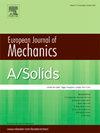An efficient coupled zigzag third-order theory for dynamic analysis of multilayered piezoelectric semiconductor plates
IF 4.2
2区 工程技术
Q1 MECHANICS
引用次数: 0
Abstract
Different from piezoelectric (PE) dielectrics, piezoelectric semiconductors (PSs) show the interaction between electromechanical field and mobile charges. This not only makes PSs have great potential for developing electronic devices, but also presents a lot of multi-field coupled problems that need to be investigated. In this paper, an efficient coupled zigzag third-order theory (CZTT) is developed for the dynamic analysis of a multilayered PS plate. The continuity of the mechanical displacements, the transverse shear stresses and the electrical fields at each layer interface are ensured. The shear traction-free condition and electrical short circuit condition are enforced at the top and bottom surfaces of the multilayered PS plates. The number of primary field variables is reduced to seven and is independent of the number of layers. The governing equations and the corresponding boundary conditions are derived using Hamilton principle. An analytical solution for a simply supported multilayered PS plate is obtained. The vibration frequency and damping for three-layer PS plates are calculated using the analytical solution and verified through the finite element (FE) simulation. The effects of steady-state electron density, different stacking sequences and thickness ratios on dynamic characteristics are discussed. The size-dependent dynamic behaviors resulting from the semiconductor (SC) property are revealed. It is shown that the dynamic behaviors can be divided into three coupling statuses according to the density value of steady-state electron. The vibration frequency is significantly weakened within a certain range of steady-state electron density due to the screen effect of free electrons. The findings could be useful to the analysis and design of layered composites made of smart PS materials.
多层压电半导体板动态分析的高效耦合之字形三阶理论
与压电(PE)介质不同,压电半导体(ps)表现出机电场与移动电荷之间的相互作用。这不仅使ps具有巨大的发展潜力,而且也提出了许多需要研究的多场耦合问题。本文建立了一种高效耦合之字形三阶理论(CZTT),用于多层PS板的动力分析。保证了各层界面处力学位移、横向剪应力和电场的连续性。多层PS板的上下表面均存在无剪切牵引力条件和电气短路条件。主场变量的数量减少到7个,并且与层数无关。利用汉密尔顿原理推导了控制方程和相应的边界条件。得到了简支多层PS板的解析解。利用解析解计算了三层PS板的振动频率和阻尼,并通过有限元仿真进行了验证。讨论了稳态电子密度、不同堆叠顺序和厚度比对动态特性的影响。揭示了由半导体(SC)特性引起的尺寸依赖的动态行为。结果表明,根据稳态电子的密度值,动力学行为可分为三种耦合状态。在一定的稳态电子密度范围内,由于自由电子的屏蔽效应,振动频率明显减弱。这一发现对智能PS材料层状复合材料的分析和设计具有重要意义。
本文章由计算机程序翻译,如有差异,请以英文原文为准。
求助全文
约1分钟内获得全文
求助全文
来源期刊
CiteScore
7.00
自引率
7.30%
发文量
275
审稿时长
48 days
期刊介绍:
The European Journal of Mechanics endash; A/Solids continues to publish articles in English in all areas of Solid Mechanics from the physical and mathematical basis to materials engineering, technological applications and methods of modern computational mechanics, both pure and applied research.

 求助内容:
求助内容: 应助结果提醒方式:
应助结果提醒方式:


